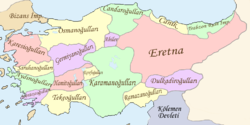|
|---|
|
|---|
| | Important centers and extension: | |
|---|
|
|
|---|
| | Important centers and extension: | |
|---|
| Dynasty: | |
|---|
| Important works: | |
|---|
|
|
|---|
| | Important centers and extension: | |
|---|
| Hasankeyf dynasty or Sökmenli dynasty: | |
|---|
| Mardin dynasty or Ilgazi dynasty: | |
|---|
| Harput dynasty: | |
|---|
|
|
|---|
| | Important centers and extension: | |
|---|
| Dynasty: | |
|---|
|
|
|---|
| | Important centers and extension: | |
|---|
| Dynasty: | |
|---|
| Erzincan and Kemah branch | |
|---|
| Divriği branch | - Mengücekli Süleyman Shah (1142- ?)
- 1277
- Beylik destroyed by Abaka
|
|---|
|
|
|---|
| | Important centers and extension: | |
|---|
| Dynasty: | |
|---|
|
|
|---|
| | Important centers and extension: | |
|---|
| Dynasty: | |
|---|
| Events | |
|---|
|
|
|---|
| | Important centers and extension: | |
|---|
| Dynasty: | |
|---|
| Sinop dynasty or Isfendiyarid dynasty : | |
|---|
|
|
|---|
| | Important centers and extension: | |
|---|
| Dynasty: | |
|---|
|
|
|---|
| | Important centers and extension: | |
|---|
| Dynasty: | |
|---|
|
|
|---|
| | Important centers and extension: | |
|---|
| Dynasty: | |
|---|
|
|
|---|
| | Important centers and extension: | |
|---|
| Dynasty: | |
|---|
|
|
|---|
| | Important centers and extension: | |
|---|
| Dynasty: | |
|---|
|
|
|---|
| | Important centers and extension: | |
|---|
| Dynasty: | |
|---|
|
|
|
|---|
| | Important centers and extension: | |
|---|
| Dynasty: | |
|---|
|
|
|---|
| | Important centers and extension: | |
|---|
| Dynasty: | |
|---|
|
|
|---|
| | Important centers and extension | |
|---|
| Dynasty: | |
|---|
|
|
|---|
| | Important centers and extension: | |
|---|
| Dynasty: | |
|---|
|
|
|---|
| | Important centers and extension: | |
|---|
| Dynasty: | |
|---|
|
|
|---|
| | Important centers and extension: | |
|---|
| Dynasty | |
|---|
|
|
|---|
| | Important centers and extension: | |
|---|
| Dynasty | |
|---|
|
|
|---|
| | Important centers and extension: | |
|---|
| Dynasty: | |
|---|
|
